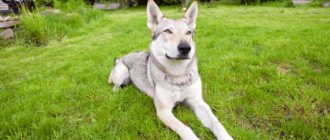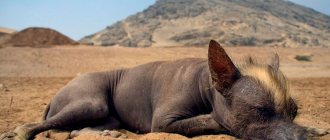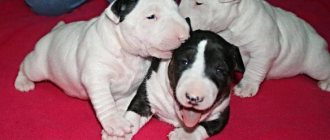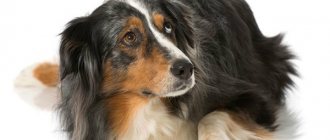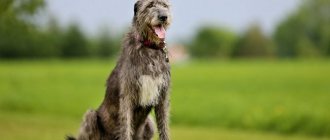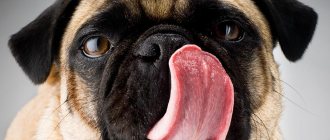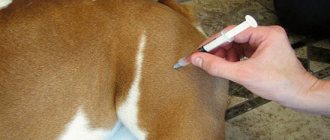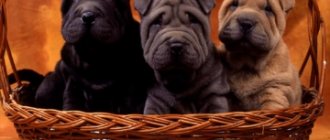Breed characteristics
| Short description | |
| Origin: | England, Yorkshire |
| Conditions of detention: | Apartment, house with or without garden |
| Purpose: | Hunter, guard |
| Color: | Yellow-brown with gray or black markings |
| Wool length: | Average |
| Adult dog size: | Female height – 56-59 cm, male height – 58-61, male weight – 23-29 kg, female – 18-20 kg |
| Average life expectancy: | 11-12 years old |
| Walk: | Need two walks a day |
| Physical activity needs: | High physical activity needs (regular or daily exercise for more than 3 hours per day) |
| Fédération Cynologique Internationale (FIC) classification: | Group 3: Terriers; section 1: large and medium terriers |
| Puppy price: | From 5,000 to 25,000 rubles. Without pedigree – 5000-6000 rubles, pet class – up to 10000 rubles, breed class – 15000 rubles, show class – 20000-25000 rubles |
How to choose a puppy and where to buy
An Airedale puppy must be purchased from a kennel. Most often, a puppy is bought by the one who likes it the most (by appearance or character). If it is purchased for exhibitions, then you need to look especially carefully at the external characteristics (breed standard) and at the baby’s parents. A small puppy must receive a vaccination passport.
The puppy is taken away from its mother at least a month after its birth. If the choice depends on the gender of the puppy, then you should remember that males are more cocky and playful and are perfect for athletic and active people. Girls are calmer and more cunning. What matters is what you name the dog. Suitable nicknames for Airedales: for males - Bars, Joe, Mike, etc., for females - Vesta, Gina, Sandy, etc.
The price depends on the place of purchase. You can buy it for 200-300 dollars; in a nursery the cost reaches 700 dollars. There are several nurseries engaged in breeding Airedale terriers: Constanta ROSS, Montikor, Dakinarus and others.
History of the origin of the species
Airedale Terriers are the result of crossing Old English Terriers and Otterhound (hound). Amateur hunters needed a dog that could bring them waterfowl and burrow game. The hounds drove the animals, and the terriers made their way into the holes and overtook them.
The formation and development of the breed officially began in 1862 , when various subspecies of Erdeles began to appear at exhibitions: wire-haired, water-haired, and coastal. A little later, the breed was given a common name, which reflected the dogs’ homeland - the valley on the Er River - Airedale Terriers.
Dogs had various functions: guard, service, hunting, companions. They helped during the world wars: they looked for the wounded, transported medicine, sniffed out mines and ammunition.
In the USSR, the breed became famous thanks to the film “The Adventures of Electronics”. Until the 90s, the Erdels were kept as companions. Now the breed is practically not used for official purposes.
Character of the Airedale Terrier
The main feature of the breed is that Airedales are overly agile. Dogs are emotional, active, sociable. They love it when they are not left without attention. A lazy owner is not suitable for keeping a dog of this breed. The dog has a cheerful disposition, she is curious, with high intelligence.
Airedale Terriers are good-natured, loyal, and affectionate dogs. Strong love for the owner can develop into jealousy towards other animals in the house. Erdel will never impose communication on the owner if he is busy or not in the mood. The dog seems to feel the person’s feelings: he will simply sit next to him and not bother him.
Airedale Terriers are calm, brave, and will never be the first to get into a fight. A dog confident in its strength will protect its owner to the end, especially in case of danger.
Attitude towards children and others
The Airedale Terrier treats people around him favorably if he does not feel hostility on their part. But if the owner has a negative attitude towards a stranger, a disapproving attitude is transmitted to the dog. The dog closely monitors human behavior. Airedale Terriers are not only smart, but also cunning, which must be taken into account when raising a pet.
Erdeli are very active: they play, frolic like children, love all family members, regardless of age.
Airedale Terriers are responsible nannies, they will never hurt a child and will not cause harm themselves.
Distinctive features
Airedale Terriers are the largest in the terrier group: 56-61 cm at the withers, 18-20 kg in weight. They are muscular, strong, well built. They can develop high speed and catch up with game. In addition, dogs are strong and resilient, work hard, and can withstand any cold weather.
- The head is long, flat, and not wide. Not large relative to the body.
- The muzzle is powerful, large, with a curved bridge of the nose and developed jaws. The bite is regular, scissor-shaped, the lips are thin and dry.
- The nose is large and black.
- The eyes are round, small, not protruding, set high and wide.
- The ears are set high, semi-erect, triangular.
- The body is strong and elongated. Short back, muscular loin, sloping croup. The chest is well descended. The neck is long.
- The tail is set high, carried straight, and usually docked.
- Limbs are long, straight, parallel. The paws are strong, with pointed toes. The movements are energetic.
- The coat is hard, wiry, of medium length with undercoat.
- Color: sandy brown with black scoop.
Additional information about the breed
Airedale Terriers are energetic and active, so they require frequent walks and regular exercise. The love for water is inherent in this breed at the genetic level. They are excellent swimmers and love to swim, so they will be happy to swim in the river. It's also a good idea to spend time with your dog during a bike ride. To do this, you will need a springer, with which you need to tie the dog to the bicycle. They are quite fast and resilient, so such a walk will bring pleasure to both the dog and the owner.
Photo of an adult dog
Historical reference
The official history of the breed is relatively short, since it began only in 1886. Naturally, Airedale Terriers did not appear out of nowhere; their recognition was preceded by a stage of development that lasted several centuries. The breed was bred in Great Britain, in the county of Yorkshire.
This is interesting! The name of the breed comes from the name of the River Aire, which borders the county of Yorkshire.
England is the homeland of many terriers, which were united by one common ancestor - the black and tan hunting dog (terrier). The ubiquity of burrowing dogs was driven by necessity. Each county had its own problem, in Yorkshire it was otters. The huge population of agile animals simply forced people to defend themselves. The same can be said about rats, which destroyed food supplies and spread viruses.
The first hunting terriers were actively used for otter hunting. In dense reeds, and sometimes in marshy areas, hunting is quite difficult and requires certain skills from the dog. The old-type black and tan terrier was a universal breed and it coped with responsibilities mediocrely. However, the reputation of the already extinct dogs was unshakable, and this became the basis for breeding a more universal hunter on the “base” of the ancient breed. The second “DNA component” (at the first stage) was the famous otter hunter – the Otterhound.
This is interesting! The coastal areas of Eira also had “sporting significance.” Burrow and parfors hunting is a cultural feature of England. Dogs claiming to be the “best” were constantly tested in competitions. Usually, abilities were tested on the pen of a fox or otter. The latter were hunted en masse in Yorkshire.
It must be said that when breeding a working dog, no special attention was paid to its appearance. The drawings preserved in the records of those years show rough, powerful dogs, slightly out of proportion, but very muscular. After breeding the first mestizos, people were faced with the problem of dog rage. Erdel, who had fallen into a state of excitement, was uncontrollable, he literally tore and threw. This situation was corrected by mating with English herding breeds.
Almost a hundred years later, the British received a hardy, trouble-free, intelligent, small but strong dog. They called the new breed the Coast Terrier. Geographically, the county of Yorkshire is located very advantageously; trade routes ran through it. Together with the ships of merchants, first fame, and then the dogs themselves spread throughout the coastal territories of Eira.
This is interesting! During the days of the old laws, when the poor of England were literally starving, Airedale Terriers were in great demand among “poachers.” The fact is that a hunting license cost a lot of money, and severe punishment awaited commoners for hunting in the reserve. People taught their students to independently track, kill and bring home small game.
Airedale Terriers, due to their size, were never used for hunting in holes, but they were irresistible working on water Representatives of the breed were used (and are still used today) as hounds, since they are excellent at picking up a scent and following it with concentration. For some period of time (albeit a short one), Airedale Terriers were “at the head” of working dogs in England. The four-legged animals accompanied police patrols at night and helped search for people and drugs.
The breed's population grew rapidly, with its first appearance in the 1860s. Relatively quickly, in 1886, the British Canine Federation entered 24 dogs of a new breed into the registers. In 1880, the first representative of the breed was exported to the USA. A stately male named Bruce performed at a show in New York and received the highest award among his den relatives (terriers).
This is interesting! During World War II, Airedale Terriers were actively used at the front. Dogs are capable of making independent decisions, assessing risks and tirelessly pursuing their goals, which has made them excellent communicators.
Tips for choosing a puppy
Potential owners should understand that behind the appearance of a small dog lies the strength and power of a real hunter. Airedale Terriers were bred to corral large predators and work on water . Representatives of the breed are capable of bear hunting. These dogs are so brave and unshakable.
Experienced trainers note that almost all mixed breeds and hybrids of Airedale Terriers are prone to passive defensive behavior. If you do not have experience raising complex breeds, then you should purchase an Airedale puppy only from officially registered ones; the reputation of the nursery must be confirmed by experience. Respectable breeders are happy to provide potential buyers with the contact information of owners who have already purchased puppies from the nursery.
Important! Even if you are not going to show the dog or are purchasing a puppy for sterilization, you have the right to familiarize yourself with the breeding documents of the producers and the conclusion of the breeding inspection of the litter.
If you have already studied offers for the sale of puppies, you have probably come across information about mini Airedales - Welsh Terriers. Contrary to rumors, the Welsh is not an ancestor of the Airedale or an “older” variety. Both breeds were developed in England and received their names from the counties (in which the breeding took place). The main differences between the Airedale Terrier and the Welsh Terrier relate to size - the Welsh are still used for burrow hunting, they are smaller than the Airedale.
Some potential owners make the unfounded conclusion that the “dwarf” Airedale Terrier is more suitable for keeping in an apartment. The Welsh Terrier is a purely hunting dog and its character is “burdened” with corresponding skills . Erdeli are taller than Welsh dogs by a good 20 centimeters, but over the years they have “adapted” and “improved”, like pets deprived of hunting.
Features of character and behavior
The breed is characterized by typical terrier behavior . They love to play, run, and have fun with people. It’s not for nothing that Erdeli are considered the “kings” of this group. Firstly, they are larger than their counterparts, and secondly, they have an original character. Previously, dogs were used for service; moderate aggression was developed in them to protect the territory. Now the breed has become exclusively decorative, and in some cases, hunting.
In general, dogs are positive, active, and friendly. But they are not suitable for beginners because they require serious, specific training. The owner will always have to negotiate with his pet and be persistent. Airedale Terriers are characterized by the habits of a leader.
Advantages
Breed advantages include:
- Good hunting instincts and physical abilities, hard work;
- Development of intelligence;
- Friendly, non-aggressive towards humans and dogs;
- Devotion to family, owner;
- Activity, energy, positivity;
- Emotional;
- It tolerates separation from its owner well.
Flaws
Disadvantages depend on the upbringing and character of the parents . Dogs from different owners may have opposite temperaments. Main breed disadvantages:
- Grudge (dogs do not tolerate rude treatment and take revenge);
- Tendency to dominate;
- Cunning;
- Avoidance of training (if Erdel is not interested, he will not work);
- Stubbornness;
- Independence.
Pros and cons of the breed
It is not for nothing that the dogs of the classic English terrier group are loved all over the world. They are very smart, energetic and attractive in appearance. Sometimes too emotional and active. But these are small representatives of FCI Group III. And a large terrier is a maximum of advantages.
For those who love and understand terriers, the Airedale terrier will be a source of continuous positivity:
- He is not stubborn or self-willed.
- Moderately active.
- Enjoys and successfully studies.
- Handsome!
The only thing that discourages this breed is the need for regular trimming. The problem can be solved with the help of a groomer and money, or you can master the technique yourself.
The versatile abilities of Airedales do not allow them to be recommended as a purely guard dog, much less a bodyguard. Perhaps this is a minus?
Care and maintenance
These dogs are unpretentious and can live both on the street and in an apartment. They don't take up much space and survive cold weather well. One way or another, your pet needs a comfortable, warm booth or bed.
Before buying a puppy, you need to determine a place for it, purchase items for daily use: a blanket, bowls on stands, toys, hygiene products.
Airedale Terriers are suitable for active people and hunters. They need to walk a lot, exercise, run.
Without sufficient exercise, your pet will lose interest in life, be lethargic, sad, and may become angry or overactive.
Nutrition
Erdels are excellent at digesting raw food , which suits them better than dry food. The final choice largely depends on the owner: his free time, financial resources, preferences.
Ready-made products are easy to use and do not require cooking.
- They contain the necessary complex of vitamins and minerals, the dog does not need additional bait.
- They are convenient to store and transport.
- You can choose the type of food based on your pet’s personal qualities: its activity, weight, gender and age.
- There are also separate types for pregnant and lactating females, allergy sufferers and older dogs.
One of the disadvantages of dry food is poor digestibility. Some products contain substances that are not suitable for dogs.
Unscrupulous marketers ignore them in the composition, so before using any food you need to read reviews about it, consult with a specialist or veterinarian.
Super-premium holistic food (grain-free food) for active medium-sized breeds is perfect for Airedales.
Natural food is considered healthy, because the owner himself develops the menu and knows what his pet eats. This option is not particularly suitable for busy people because cooking wastes time. Dogs are unpretentious, but they need proteins and carbohydrates in their diet:
- Meat (beef, lamb, chicken, turkey, rabbit; 30-40% of the diet);
- Fish (sea fish without bones; once a week);
- Eggs (boiled 2 times a week);
- Fermented milk products (low-fat kefir and cottage cheese 2 times a week);
- Cereals (whole grain dry bread; oatmeal, buckwheat or rice porridge, boiled in water or broth);
- Vegetables and fruits.
You should not feed your dog pork, bones, butter, legumes, white bread, potatoes, citrus fruits and exotic fruits. It is not recommended to mix dry and natural products or feed the pet from the owners’ table.
It is important to maintain a drinking regime; a bowl of clean, disinfected water should always be full. If the puppy does not drink water on its own, then it must be given water from a pipette or syringe. In the summer, people take water for walks.
On average, an adult Airedale Terrier needs 500-600 grams of food per day. The serving size depends on the time of year, more food is needed in winter), living conditions (street dogs need more food), weight and activity of the animal. Meals are divided into two times: morning and evening. Puppies up to 3 months are fed 4-5 times a day, six-month-olds - 3 times, and by the age of one year they are transferred to two meals a day.
We recommend that you read a detailed article on the topic: “How and what to feed a dog: types and characteristics of nutrition.”
Health
Airedale Terriers are medium-sized dogs with good immunity and good health. Average life expectancy is 10-13 years. To get a healthy puppy, you need to contact only nurseries with good reviews, find out about the parents’ diseases, and check the dog for pathologies at a veterinary clinic.
Do not neglect annual vaccinations and trips to the veterinarian. You must also follow all rules of maintenance and care.
Vaccinations
Even lap dogs that don't go outside need vaccinations. A person carries millions of bacteria and viruses on himself and on his clothes, which can be dangerous for the animal. Hunting dogs like the Airedale Terrier require vaccination. Pets encounter wild animals, which are often carriers of the disease.
First of all, dogs are vaccinated with a complex drug against enteritis, distemper, influenza, leptospirosis, salmonellosis and other infections. They do this at 2, 2.5, 6 and 12 months . The procedure requires annual repetition; the effect of the vaccination is short-lived.
The second important vaccination is against rabies. It is carried out at 7 months and is repeated annually. Vaccinations are not only done to protect the pet. Without the necessary stamps in the veterinary passport, it cannot be transported abroad. According to the laws of the Russian Federation, the import of animals is allowed if all the necessary vaccinations (2 drugs) have been carried out in the last 12 months, but no later than 20 days before transportation.
The primary vaccination is usually carried out by the kennel, where documents for the dog are prepared. The owner will be notified when the vaccination was given and what schedule to follow.
For the procedures to go well, you need to adhere to the following rules:
- Before the second vaccination, the dog cannot be walked; after each procedure, you must undergo quarantine (2 weeks);
- Before vaccination (2 weeks), the pet is cleared of worms;
- On the day of vaccination, the puppy’s temperature is measured; sick, malnourished pets and pregnant females are not allowed to participate in the procedure;
- Vaccinations are carried out in a veterinary clinic by experienced specialists in order to quickly save the dog in case of an allergic reaction;
- If side effects (nausea, lethargy, refusal to eat) last longer than a day, you need to contact a veterinarian.
Vaccination does not provide 100% protection against infections; there is always a chance of contracting the disease . Unvaccinated animals tolerate treatment and the disease itself much worse, and most often do not survive. Vaccination helps your pet overcome the virus. But it is important to monitor what your pet picks up from the ground during walks and with whom it communicates.
Important article on the topic: “Everything you need to know about dog vaccinations.”
Diseases
The main and most terrible disease is considered to be dysplasia of the joints: elbow and hip. It develops due to overeating, obesity or too much exercise in the early years.
- The disease is expressed by deformation of the paws, acute pain, and lameness. Unfortunately, the problem cannot be corrected, but your pet’s life can be made easier with medications or surgery.
- Airedale Terriers often suffer from skin diseases and rashes that cause severe itching. This occurs due to allergic reactions, hypothyroidism or ingrown hairs.
- In addition, there are digestive problems: gastric volvulus, constipation and nausea.
Walk
The breed was bred for hunting, so its representatives have a lot of energy. Walking is necessary for Erdeles. Even if kept outdoors, it is necessary to take your pet out to parks and crowded places. Training is carried out at least 3 times a week. If possible, they organize a hunt.
After the second vaccination, puppies are accustomed to the street. First they carry him out in his arms, then put him on a leash and walk him in quiet places. When the dog gets used to the environment, you can continue socialization: walk along noisy crowded streets, carry your pet on the bus, introduce it to other animals.
Grooming
The breed is not prone to heavy shedding and does not have a specific odor. But the coat requires some care: daily combing with a slicker and trimming 2-4 times a year . The procedure can be performed independently using forceps; lessons on the technique are available on the Internet; Or you can take your pet to the groomer. Erdeleys get their hair cut in the summer.
The rest of the care is standard. Daily examination of teeth, eyes and ears, cleaning as they become dirty. Not all pets love these procedures, so they need to be taught from childhood, encouraged with treats, and played while bathing and brushing. If a dog’s nails do not wear off on the asphalt, then they should be trimmed once a month.
Deworming treatment is required every 2 months. During the summer, animals are checked for fleas and ticks and bathed in special solutions to prevent their appearance. You can use protective collars, powders and suspensions.
Nutrition
The Airedale Terrier breed can sometimes suffer from food allergies. In addition, intestinal problems are common. Therefore, it is important for the owner to know a few rules that will help avoid health problems:
- it is important to give only fresh food;
- if we are talking about dry factory food, then you need to choose premium category food;
- feedings are carried out strictly according to the schedule;
- Changing the diet is prohibited, and the introduction of new products occurs gradually;
- if we are talking about natural nutrition, then dishes for the dog need to be prepared daily;
- food should be varied and slightly warmed;
- young dogs may not feel full and ask for more - it is important to be persistent and refuse the pet, but at the next feeding slightly increase the dosage;
- food left in the bowl after eating must be disposed of after 20 minutes;
- It is important to ensure constant access to clean drinking water.
During the first two months of life, the Airedale Terrier must feed on its mother's milk. At two or three months, the dog tries new food for the first time and eats up to 5-6 times a day until six months. Then the number of feedings decreases, and the volume of portions increases. By 10-12 months, a dog can go without food for up to 10 hours, so feeding it more than twice a day is not recommended.
The dog's diet includes meat, sea fish, as well as fermented milk products, cereals and vegetables. As for meat, any lean variety except pork will do. You can give them unprocessed, but pre-process them so that the dog does not contract the disease.
Among fermented milk products, the leading place should be occupied by low-fat varieties of yogurt, kefir, and cottage cheese. But it’s better not to give milk. Among the cereals, buckwheat and rice predominate. Vegetables are local and seasonal. Sometimes the dog should be pampered with fruits, such as apples.
But it’s better not to give citrus fruits. Fried, smoked, spicy foods and spices should be excluded. Chocolate and baked goods, as well as salt, are prohibited. In addition to natural nutrition, it is necessary to provide additional vitamins and minerals. They are already included in dry food.
Mating
Mating of Erdeles is no different from mating of other dogs. Terriers are not large and do not require a lot of space or special conditions. Of course, the first time the animals need help. It is best to invite a specialist who will tell the owners how to behave.
If the dogs have all the necessary documents and are breeding dogs, then the mating must be carried out through a kennel. There, the owners will fill out forms and receive directions for mating. The partner is selected there. Animals must complement each other (the disadvantages of one are offset by the advantages of the other).
The owners agree on the date of mating and negotiate the price. Usually, the owner of the boy chooses between 1 puppy and a certain percentage of its cost (50% if there are 2-3 puppies in the litter, 75% if there are 4).
Dogs are allowed to knit only from the age of 2 years, although puberty comes at 8 months. The best time for mating is 13-15 days of the third estrus, the girl is physically ready to bear and give birth to offspring. Primary signs should appear - loosening of the loop, light discharge and a particularly playful mood. Within 2 weeks, the animals are cleared of worms and checked for pathologies in a veterinary clinic.
On the appointed day, the girl is brought to the territory to the male dog. Here the male will feel relaxed. The pets are walked together, given time to socialize and get to know each other. The female will allow you to cage if she likes everything.
The act lasts about 10 minutes , during which time the female is held by the head and under the belly, and the male is directed into a noose. Animals can stand in the castle for 15-20 minutes , but if it was not there, then the girl may be overweight. Mating is repeated after 2 days , and the course of pregnancy is monitored in a veterinary clinic.
Read a detailed article on the topic: “Everything you need to know about breeding dogs: appropriate age, what to do if it doesn’t work out, rules and tips.”
Airedale Terrier Health and Diseases
Possible diseases
Most often, dogs suffer from improper development of the hip joints, which can lead to dislocation of the femoral head. Depending on the stage of developing dysplasia, drug or surgical treatment is used. In addition to this disease, animals have a predisposition to:
- raw eczema appearing on the paws and face;
- dystrophy and clouding of the cornea;
- von Willebrand-Diana disease, accompanied by spontaneous bleeding from the nose when visiting the toilet or undergoing surgery;
- inversion of the eyelids;
- umbilical hernia, aggravated by increased gas formation due to improper feeding;
- lymphoma;
- demodicosis, which affects the ears, tail and other parts of the body attacked by ticks;
- hypothyroidism, which disrupts hormonal metabolism and is accompanied by obesity and hair loss;
- dilated cardiomyopathy, fraught with heart failure;
- retinal atrophy;
- hyperadrenocorticism;
- melanoma.
The energy and endurance inherent in the breed do not always protect against inherited diseases. The dog's health can be protected by performing a simple set of preventive measures, including compliance with the vaccination schedule, seasonal anti-parasitic treatment and an annual visit to the veterinarian.
Reproductive health
The time of the first heat varies from person to person. For large breeds, adulthood takes 12-18 months. Pregnancy can be planned from 18 months, when physiological development is complemented by psychological stability. Earlier matings are fraught with difficult childbirth, death of the mother or the entire offspring. The birth of puppies occurs on days 62-65 after successful mating.
There can be up to 13 puppies in one litter, so raising that many dogs is very difficult. If breeding is not your thing, then be sure to sterilize your pet. Sterilization not only protects the animal from cancer, but also has a positive effect on the character, protecting it from monthly hormonal changes.
Key points in training
The main negative trait of the breed is stubbornness, so standard methods of motivation do not work with these dogs.
Read about how to properly train a dog in the article: “Training a puppy: effective methods from dog handlers, learning commands at home.”
There is also no point in beating animals; they practically do not feel pain.
In the case of Erdeles, you need to look for a special approach, be able to negotiate and communicate with the dog. It is important to accustom your pet to training from childhood, to interest him in games and entertainment. If you miss the moment, this dog will become uncontrollable.
The animal must be accustomed to the rules of behavior in the house and on the street. The dog must understand the hierarchy in the family; it must not sleep, jump on the owner’s furniture, beg, or steal. By 3-4 months, the terrier will have already learned its schedule and nickname, then you can start learning commands.
Airedels are great at agility. They can become service dogs and protect the territory entrusted to them. But for this you need to work more seriously with the dog, take training courses in kennel clubs.
It is important to properly socialize your pet. To do this, he is introduced to people and animals, taken for walks in crowded places, and taught to use a leash. An unsocialized dog can become aggressive or timid.
How to train
When raising and training, it is important to know the characteristics of the Airedale Terrier breed. They tend to be stubborn, which can create difficulties for inexperienced dog owners. If the dog is stubborn, there is no way to force him to follow commands. In this case, it is necessary to take into account the individual characteristics of each dog. Some animals can be dealt with with affection, while other animals can be dealt with with harsh (but not cruel) force.
From an early age, a puppy needs to be educated, otherwise he will be bored with following commands and training will be out of the question. At the most crucial moment, the dog will stop obeying. This can manifest itself not only in training. Therefore, it is necessary to begin training as soon as the pet appears in the house. We need to make sure that he enjoys the training.
Representatives of the breed have a very good memory, so what they learn is remembered for a lifetime. However, repetition is important. It is required to let the puppy run without a leash. Gradually, he can be accustomed to the “come” command. When the puppy runs up, you need to fasten him to the leash for a short time and let him go again, while giving him some kind of treat.
By three months, the puppy should know its name and commands: come to me, place, no. Then the Airedale is taught to overcome barriers (first up to 10 cm in height, no more than twice). At the same time, he can be interested in a ball or a stick. If he refuses to jump, he should not be forced. Also, from three months of age, they learn commands: sit, lie down, stand.
